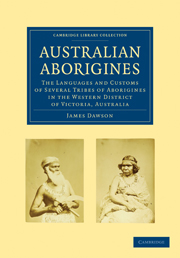 Australian Aborigines
Australian Aborigines Book contents
- Frontmatter
- PREFACE
- INTRODUCTORY NOTE
- Contents
- YARRUUN PARPUR TARNEEN
- CHAPTER I TRIBES
- CHAPTER II POPULATION
- CHAPTER III CHIEFS
- CHAPTER IV PROPERTY
- CHAPTER V CLOTHING
- CHAPTER VI HABITATIONS
- CHAPTER VII CLEANLINESS
- CHAPTER VIII DOMESTIC FURNITURE
- CHAPTER IX COOKING AND FOOD
- CHAPTER X TOOLS
- CHAPTER XI LAWS OF MARRIAGE
- CHAPTER XII CHILDREN
- CHAPTER XIII NAMES OF PERSONS
- CHAPTER XIV SUPERSTITIONS AND DISEASES
- CHAPTER XV DEATH AND BURIAL
- CHAPTER XVI AVENGING OF DEATH
- CHAPTER XVII GREAT MEETINGS
- CHAPTER XVIII AMUSEMENTS
- CHAPTER XIX WEAPONS
- CHAPTER XX ANIMALS
- CHAPTER XXI METEOROLOGY, ASTRONOMY, ETC
- CHAPTER XXII NATIVE MOUNDS
- CHAPTER XXIII ANECDOTES
- CONVEYANCE, BY PRINCIPAL CHIEFS TO JOHN BATMAN, OF 100,000 ACRES OF LAND, BETWEEN GEELONG AND QUEENSCLIFF
- VOCABULARIES.—WORDS; ANIMALS; RELATIONSHIPS; NAMES OF PLACES; GRAMMAR AND SENTENCES; NUMERALS
- NOTES
- Frontmatter
- PREFACE
- INTRODUCTORY NOTE
- Contents
- YARRUUN PARPUR TARNEEN
- CHAPTER I TRIBES
- CHAPTER II POPULATION
- CHAPTER III CHIEFS
- CHAPTER IV PROPERTY
- CHAPTER V CLOTHING
- CHAPTER VI HABITATIONS
- CHAPTER VII CLEANLINESS
- CHAPTER VIII DOMESTIC FURNITURE
- CHAPTER IX COOKING AND FOOD
- CHAPTER X TOOLS
- CHAPTER XI LAWS OF MARRIAGE
- CHAPTER XII CHILDREN
- CHAPTER XIII NAMES OF PERSONS
- CHAPTER XIV SUPERSTITIONS AND DISEASES
- CHAPTER XV DEATH AND BURIAL
- CHAPTER XVI AVENGING OF DEATH
- CHAPTER XVII GREAT MEETINGS
- CHAPTER XVIII AMUSEMENTS
- CHAPTER XIX WEAPONS
- CHAPTER XX ANIMALS
- CHAPTER XXI METEOROLOGY, ASTRONOMY, ETC
- CHAPTER XXII NATIVE MOUNDS
- CHAPTER XXIII ANECDOTES
- CONVEYANCE, BY PRINCIPAL CHIEFS TO JOHN BATMAN, OF 100,000 ACRES OF LAND, BETWEEN GEELONG AND QUEENSCLIFF
- VOCABULARIES.—WORDS; ANIMALS; RELATIONSHIPS; NAMES OF PLACES; GRAMMAR AND SENTENCES; NUMERALS
- NOTES
Summary
As it has been found almost impossible to represent the correct sounds of the Australasian languages by adhering to the rules of English orthography, these rules have been necessarily laid aside, together with the signs of accentuation. Double consonants are used to express emphasis, and double vowels to express prolongation of the sound. People who are unacquainted with the difficulty of communicating in writing the pronunciation and sound of foreign words may cavil at the employment of so many double letters, but this mode has been adopted, after very careful consideration, as the most suitable for the purpose.
The following examples will fully illustrate what is meant. The English word ‘car’ would be ‘kaar,’ ‘can’ would be ‘kann,’ ‘rain’ would be ‘rææn,’ ‘rainy’ would be ‘ræægnæ,’ ‘meat’ would be ‘meet,’ ‘met’ would be ‘mett,’ ‘life’ would be ‘liif,’ ‘live’ would be ‘livv,’ ‘tome’ would be ‘toom,’ ‘torn’ would be ‘tomm,’ ‘boot’ would be ‘buut,’ ‘cut’ would be ‘kutt,’ ‘one’ would be ‘wunn,’ ‘magpie’ would be ‘magpii,’ ‘pussy cat’ would be ‘puusæ katt.’ The k and g which appear before consonants in the syllables of many aboriginal words represent sounds barely perceptible, yet indispensible to right pronunciation. The nasal sound of ‘gn’ or ‘ng’ often occurs at the beginning of syllables in the aboriginal languages. As it is found at the beginning of, and only occurs in words like poignant and poignard, derived from a foreign source, it is somewhat difficult for English people to pronounce it.
- Type
- Chapter
- Information
- Australian AboriginesThe Languages and Customs of Several Tribes of Aborigines in the Western District of Victoria, Australia, pp. viPublisher: Cambridge University PressPrint publication year: 2009First published in: 1881


